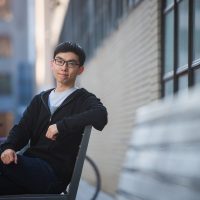News
Mining valuable insights from diamonds
If Changhao Li were to trace the origins of his love of nature, he would point to the time when he was 9, observing the night sky from his childhood home in the small town of Jinan, China. “At that moment I felt that nature is so beautiful, I just wanted to go outside the Earth, to go to the moon or even Mars,” Li remembers.
That childhood dream seeded his love of physics, which he pursued through middle and high school, and eventually at Xi’an Jiaotong University in China.
Li’s passion for the skies has since taken a more earthbound and microscopic form: It has translated into a love of quantum physics. Li is a fifth-year doctoral candidate in the Department of Nuclear Science and Engineering (NSE) and researches quantum information science, including quantum sensing and computation, with Professor Paola Cappellaro.
Quantum leaps
The primary thesis driving quantum information science is that altering the state of a material at a subatomic level can make a significant impact at much larger scales. Quantum computing, for example, depends on the most minute changes in material properties to store and process more information than a simple classical binary mode could.
The basic unit of information in quantum computing, equivalent to a bit in classical computers, is called a qubit. Exploiting defects in material structures is one way to manufacture these qubits.
An aspect of Li’s research focuses on defects in very small diamonds, some of which are on the nanometer scale. Experiments involve introducing an atomic-scale defect, known as nitrogen vacancy centers, in these diamonds, and subjecting the defects to extremely minute perturbations, using microwaves or lasers, to create and control quantum states.
One of Li’s projects measures the fluorescence emitted by a disturbed diamond to give us more information about the external stimulus. Just like you would measure an oven’s temperature to gauge how hot it is, measuring the fluorescence emitted by such a defective diamond can tell us what it is sensing and by how much. For example, a sensor that could detect even a few hundreds of strands of the SARS-CoV-2 virus that causes Covid-19 is one of the applications that Li is exploring with his colleagues.
